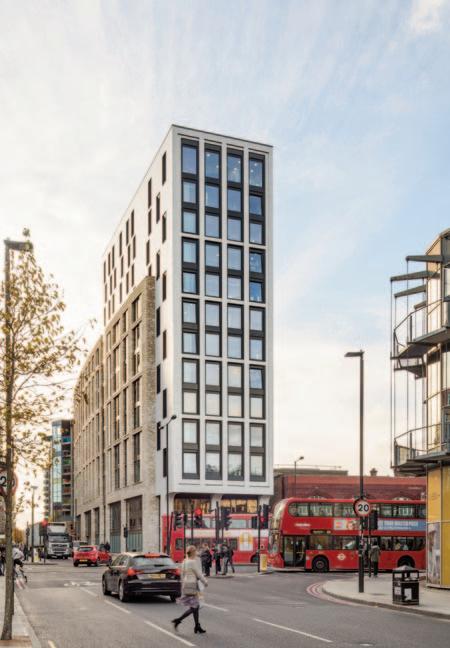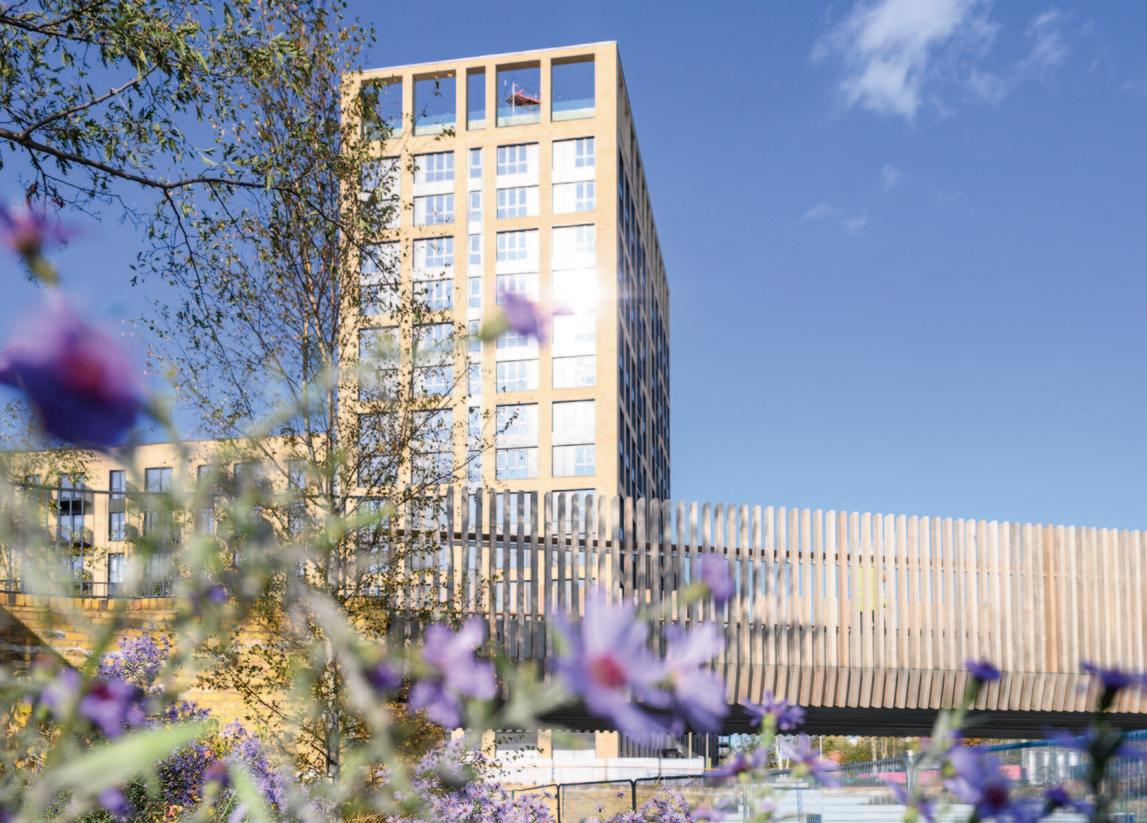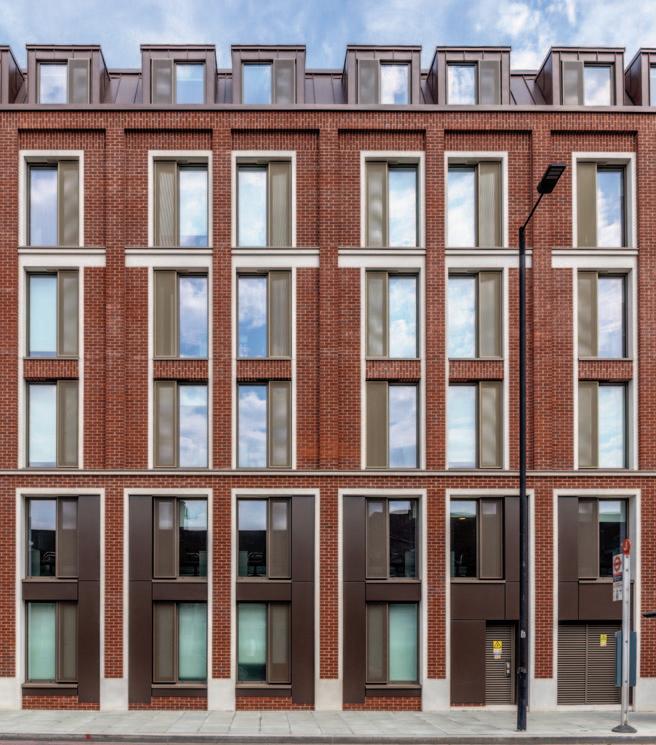
7 minute read
MODULAR BUILDING
Build Homes, Build Jobs, Build Innovation
Mike De’Ath outlines the thinking behind the report he has co-authored with Mark Farmer
RIGHT: Holloway Ride modular building by HTA Design
Mike De’Ath is a partner in HTA Design We stand at a critical juncture in our nation’s history. The global Covid-19 pandemic has had a structural impact on our society and economy in a way we could not have imagined even a few months ago. What the UK now faces is the critical task of rebuilding confidence across a range of areas including public health, job security, consumer spending, and of course the housing market.
There is no doubt that we are in a period of massive disruption for housing delivery, with the potential for significant lasting impact. The Government has previously stated its objective to deliver 300,000 homes a year by 2025 to meet the country’s needs, whilst the Prime Minister has promised that his Government will ‘Build, Build, Build’, putting investment at the heart of the post-pandemic recovery, with housing clearly on the agenda. The recent Planning White Paper also offers opportunity, removing some of the hurdles to ambitious investment in housing delivery, and accelerating the procurement and design process through the introduction of pattern books and design codes.
In our recently published whitepaper, Build Homes, Build Jobs, Build Innovation, my friend and colleague Mark Farmer (Government MMC champion and CEO of Cast Consultancy) and I propose that modular construction should play a key role in the UK’s recovery, with the potential delivery of 75,000 new modular homes a year, creating 50,000 new jobs, reducing carbon emissions by 40 per cent, and delivering on the Government’s levelling up agenda.
As practitioners, we have benefited from operating with long term relationships in sectors which have ebbed and flowed through the three most recent recessions, giving us some insight into how the government and housing market might react to the predicted slowdown that will follow the current pandemic.
The urgency for creating a multiplier effect in the post pandemic economy is unprecedented. Any measures need to flow both into the construction supply chain and, in turn, the wider market in a way that supports economic recovery as well as the UK target to achieve a net zero carbon economy by 2050.
We are seeking to create a platform for significant additional housing delivery and market diversification that also places modern methods of construction (MMC) and, particularly, modular manufactured housing at the heart of making quality homes. In doing so we envisage a major industrial strategy boost that moves us towards a greener future with resulting jobs and opportunities.
The past decade has seen significant growth in the use of modular construction in the UK and at HTA Design we have long championed its many benefits, delivering numerous envelope-pushing projects across the country. Despite this modular is yet to make it into the mainstream in housing delivery.
One major hurdle has been the planning system: Planning has been the punchbag for the failure to deliver homes for many years, particularly for housebuilders, and it’s not hard to see why. I personally have sat in many planning committees where several years of work and investment of, sometimes, millions of pounds of clients’ money comes down to some pretty alarming conversations between members, on occasion incredibly ill informed, who had just considered a rear extension in the same session.
Modern (including modular) methods of construction (MMC) necessitate a high up-front investment cost, as well as certainty: production slots must be booked in factories, with potentially hundreds of people relying on jobs in a production line. The risks posed by the present planning system, often incurring lengthy delays, are unsurprisingly prohibitive to the kind of pipelines that manufacturers must work with. In our consultation process, manufacturers overwhelmingly told us it was impossible to invest in greater delivery, where planning created a binary outcome that could mean a huge gap in the production line.
For modular manufacture to scale up we need a long-term visible pipeline of demand that allows the investment necessary to build, we believe, a further 75,000 additional homes a year by 2030. The Government’s Planning For The Future white

paper provides an opportunity to transform the system, potentially opening up a far swifter and less costly approval process, which will give modular construction its chance to become an increasingly viable and mainstream form of construction, helping to deliver much needed homes across all tenures.
The white paper also represents a great opportunity to use a more digitised and progressive planning system to enable a whole new generation of digitally designed and manufactured high quality homes using mass customisable pattern books to align to local design codes, creating beautiful, high quality homes that are appropriate to their local context, at maximum speed.
As well as quality, lower carbon, reduced waste and reduced disruption, the phenomenal speed with which homes can be delivered is perhaps the biggest benefit of modular construction. Our country needs this after 40 years of failure to keep up with demand.
This key feature of modular delivery is one of the main attractions for us as designers. Often, we find projects in a traditional process are designed without a contractor on board, using costings based on market research up to planning. On consent the scheme is tendered at which point extensive ‘value engineering’ is applied either with the client knowledge, and sometimes without it, in a ‘design and build’ contract. Sadly, we find such schemes are often quite different to the consented vision, often with the design architect being replaced by delivery architects without the commitment to the original design intent. There are

also obviously now questions regarding construction and material defects which are coming to the fore on buildings which are effectively ‘one-offs’, where continuous improvement is just not a realistic principle.
If a modular manufacturer is engaged from the outset, with a system that is flexible and responsive to local context, the architect, who should consider themselves a ‘designer in industry’ can create beautiful homes at planning stage that will be the same delivered post approval.
A manufacturer is not interested in testing the market for a better price, extensive value engineering or waiting for market prices increases. The costs are largely known at planning stage and the prime motivation is productivity in the factory.
We concluded that the most important step to achieve the growth in modular manufactured homes was to create a smooth, sustained, long-term pipeline of demand that is visible and appropriate for modular delivery. To do this we are calling for greater collaboration and aggregation of demand by the public sector, underpinning the nascent growth in municipal housebuilding. This requires the spanning of planning jurisdictions with a pooling of knowledge, processes, standards, R&D, typologies, land and commitment into a programme of scale that can be aligned to capacity and readily manufactured.
Fundamentally, our requests of Government are as follows: • Modular must be placed at the heart of policy and the ‘build build build’ agenda, with co-ordination between BEIS, HMT and
ABOVE: Greenford Quay modular building by HTA Design
RIGHT: Padnall Lakes modular building by HTA Design


MHCLG to implement modular homebuilding activity as a primary lever for levelling up the UK. • Additional funding must be allocated to more diverse forms of housing that can be absorbed quickly into the market with linked targets for modular housebuilding, building further on the recent announcement of MMC targets being set in the 2021 – 2026 Affordable Housing Programme. • We must capitalise on the planning white paper’s ideas to promote more rules-based and codified planning to help accelerate modular delivery and create beautiful manufactured homes. • Homes England must create a national level brokerage platform, that simplifies the procurement process by bringing buyers and sellers of modular housing together at a scale that allows the market to grow sustainably.
Our propositions require a change in planning, and design codes and zoning proposed in the white paper could be the opportunity to bring a new digitised environment for precision manufacture of homes on the scale that the country needs. There is no doubting the challenges ahead, but the potential to transform housing delivery so lacking for the past four decades, could be a positive to come from the pandemic and one we at HTA, along with Mark Farmer and our industry consultees, are keen to help realise.
Our ask of government is simple: help us stimulate and then galvanise the demand for modular homebuilding. With this help, a sustained long-term pipeline can underpin investment in manufacturing to deliver the quality homes we need, creating the jobs we want. n







